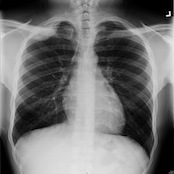Researchers have developed a breath test that has the ability to detect lung cancer and differentiate between malignant or benign lesions. Though the technology is still in the early stages of development, it is a promising step in the improved detection of lung cancer without invasive tests or CT imaging.
A Deadly Problem
Lung cancer is one of the most prevalent cancers, making up 28 percent of cancer deaths. This number makes up more deaths from lung cancer than breast, colon, pancreatic and prostate cancers combined. The survival rate for lung cancer can vary depending on where the tumors are found, but ultimately rests at a devastating 16.3 percent of patients living five years after an initial diagnosis. Less than half the patients will survive one year after their diagnosis.
Preliminary Data Promising
New technology to detect lung cancer early is desperately needed, and this new breath test seems to fit the bill. The test uses mass spectrometry and a silicon microprocessor to detect the presence of organic compounds that are exhaled by patients with lung malignancies. The test found an elevation of three or four of these organic compounds had a 95 percent predictive rate for malignancy. The absence of these elevated levels correctly predicted a benign mass in 80 percent of patients.
Potential to Save Lives
Breath test technology would be a great way to acknowledge those patients in the early stages of lung cancer. Patients with high risk factors could be identified and take the test before the disease spreads to other parts of the body — with a deadly cancer like this, the earlier a malignancy can be detected, the better the chance of successful treatment.
More Research Needed
Of course, to be instituted in practice, the breath test needs to be refined, tested on a mass scale and then developed for routine use in hospitals and clinics. With further inquiry, it will hopefully lead to improved patient outcomes and better survival rates.
From a nurse's perspective, it's important to advocate for further research in this field and until then, to continue to raise awareness of lung cancer screening and treatment. Additionally, nurses should recommend that patients avoid smoking, as smoking is associated with over 80 percent of lung cancer cases. This includes secondhand smoke exposure, because that also contributes to the development of malignancies in the lungs. Today's nurses are in a unique position to take on both of these roles, to advocate for research and encourage individual patients to take steps to improve their health.
Photo Source: Flickr
[cf]skyword_tracking_tag[/cf]

